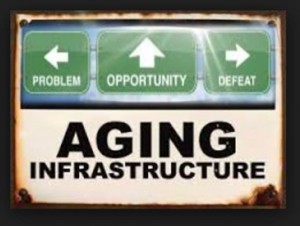John Oliver recently had the most brilliant riff on the sorry state of U.S. infrastructure. Dams, bridges, tunnels and roads are crumbling around us. The need for repair is undeniable. The cost for repair is astronomical. The funding mechanism for repair continues to be a political football. (why am I not surprised?)
Since we apparently have some time before repair begins, let’s set aside the economic cost for a the time being. Let’s consider the ecological cost of all of these needed repairs for a moment. What do all of these infrastructure projects have in common (besides job creation)? Concrete. Lots and lots of concrete. Concrete, or more specifically cement – the primary component thereof, is not just heavy, but carries a very hefty carbon footprint as well. The cement industry alone accounts for 5% of the world’s GHG emissions. The emissions are partly due to the fact that the production process pulls out CO2 from limestone to get to the good stuff – calcium oxide. A good chunk of the rest of the emissions comes from the energy needed to produce this reaction.
What if there was a way to repair infrastructure without incurring such a heavy footprint? What if, instead of incurring a net positive carbon impact, there was a way to actually sequester carbon amidst all of the newly repaired infrastructure? Here is how that might be possible.
One of the suggested solutions for mitigating cement’s emissions focuses on blended cements. Sadly they suggest coal fly ash and blast furnace slag as blending agents, both of which may contain toxins. Fortunately regulations may prevent those particular blends from becoming too popular. Blending with biochar could be the solution to the carbon woes of cement in more ways than one. Not only might it be feasible to use the heat from the biochar production process to induce calcination (separation of the ingredients in limestone), but the biochar produced could be the blending ingredient of choice. Research on the use of biochar in building materials is moving along with great promise and enthusiasm in Europe yet curiously on this side of the pond it is still very much in the grass roots stage.
It sure seems like a (dam) fine time to turn such a dire problem into an opportunity. Perhaps it is time cast off our tunnel vision and create the road less traveled with biochar blended concrete. As the saying goes in the world of deep change, this would surely be ‘Building the Bridge as you Walk on It’!


